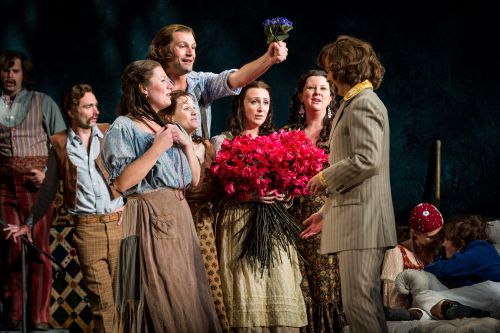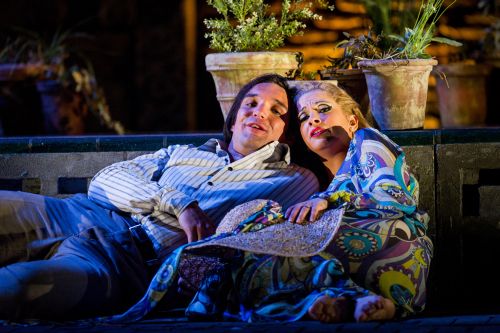 United Kingdom Mozart, Le nozze di Figaro: Soloists, The Glyndebourne Chorus and The London Philharmonic Orchestra / Jérémie Rhorer (conductor), Glyndebourne Opera Theatre, Sussex, 8.6.2013 (MMB)
United Kingdom Mozart, Le nozze di Figaro: Soloists, The Glyndebourne Chorus and The London Philharmonic Orchestra / Jérémie Rhorer (conductor), Glyndebourne Opera Theatre, Sussex, 8.6.2013 (MMB)
Cast:
Figaro: Adam Plachetka
Susanna: Laura Tatulescu
Bartolo: Luciano di Pasquale
Marcellina: Anne Mason
Cherubino: Lydia Teuscher
Don Basilio: Timothy Robinson
Countess Almaviva: Amanda Majeski
Count Almaviva: Joshua Hopkins
Antonio: Nicholas Folwell
Don Curzio: Alasdair Elliott
Barbarina: Sara Lian Owen
First Bridesmaid: Charlotte Beament
Second Bridesmaid: Annie Fredriksson
Production:
Director: Michael Grandage
Revival Director: Ian Rutherford
Designer: Christopher Oram
Lightening Designer: Paule Constable
Movement Director: Ben Wright

Photo (c) Robert Workman
In early March of this year, I interviewed David Pickard, general director of Glyndebourne Opera. Among other things I asked him why the revival of Mozart’s Le nozze di Figaro for this year’s festival. Mr Pickard gave me a very honest answer (and I quote): “…when we compile a season, we think about different periods of operas; we think about some operas that are popular and some operas that are less popular; we think about a chorus allocation across the season – we can’t have too many big chorus pieces – and crucially, as the way that we’re funded means that we need to sell 95% capacity of our seats, I will be completely honest and say that Figaro and Pasquale are popular operas; so, from a commercial point of view it’s important to have these things in. Having said that, I don’t think that anyone ever complains about The Marriage of Figaro being played at Glyndebourne…” Indeed not. A piece as beautiful and faultless as Mozart’s Figaro is always welcome. But there are other reasons for Glyndebourne to choose to revive this particular piece: Mozart’s Figaro was the first production ever to be performed at Glyndebourne in the original opera house (1934) and again in the new opera house (1994).
Le nozze di Figaro was not always as successful as it is today. In fact, after its premiere, on 1st May 1786 at the Burgtheater in Vienna, it received less than ten performances. It was only later, in December of that same year, that it became a resounding success in Prague, receiving performances throughout January of the following year.
Mozart’s Le nozze di Figaro is classical opera at its best and as such his music is timeless. To me, this is what Michael Grandage tried to demonstrate with his production of Le nozze di Figaro, first seen at Glyndebourne in last year’s festival. Grandage transports the action to the 1960s, which is immediately apparent when the Count and Countess enter the stage driving an authentic Austin Healey while the orchestra is playing the opera’s Overture. The car is on stage for only a few minutes but its impact on the audience was undeniable – there were laughs and loud applause – and it successfully sets the tone for the whole opera. If you would like to know more about the car, there is an interesting little video on the Glyndebourne website that tells the story of the Austin Healey and how it was built for the premiere in 2012.
Grandage’s idea of setting the opera in the 1960s is rather refreshing and it does work extremely well as comedy; however, the political ideas embedded in the piece by Mozart and da Ponte are lost. I am of course referring to the dark story of the class struggle depicted in the relationship of Figaro (the servant) with his master (Count Almaviva), present in Beaumarchais’s play as well, and which some people say predict what was to come with the French Revolution only a few years later. The subject of the droit de seigneur, which the Count is intending to restore in order to make Susanna his lover by his right as lord and master, makes no sense in modern times. So, for the piece to be effective in the 1960s, one must forget this aspect and look at the Count as a representative of the flower-power-free-love movement that broke up with conventions in terms of love and marriage. Once, this is managed then Grandage’s production becomes quite brilliant and imaginative.
I have already mentioned the gorgeous Austin Healey at the start of the opera but there is more and I am not only talking about the costumes and hair-dos. The scenes immediately after the double wedding of Figaro with Susanna and Don Bartolo with Marcellina are not only very funny but also a real stroke of genius. They begin with the performers dancing a stylised, slow twist, naturally to the music of Mozart, and finish in a perfectly choreographed group dance almost in the “Gangnam Style” of South Korean artist Psy. Again, this brought many laughs from the audience and well-deserved loud applause.

(c) Robert Workman
The cast chosen for 2013 was good, solid and effective in their roles, both the singing and the acting. Figaro and Susanna played respectively by Czech bass-baritone Adam Plachetka and US born soprano Laura Tatulescu are very good together. Their comic timing is spotless and they provide many hilarious as well as touching moments. Plachetka was in fine voice. His tone is powerful and sonorous; his Figaro is charismatic, endearing but at times, also a little threatening. His rendition of the cavatina Se vuol ballare, signor contino, leaves no room for doubt that he will deal with the Count’s less than honourable intentions in whatever way he, Figaro, may deem necessary to preserve his own honour and that of his future wife. Tatulescu is a sassy, sweet Susanna and she negotiates the role extremely well though, personally, I thought her voice was a little thin, particularly in its highest range. Young German soprano Lydia Teuscher is excellent as Cherubino, giving one of the best performances of the evening, singing her two beautiful, famous pieces flawlessly and creating a very convincing young man attracted to all women. Canadian baritone Joshua Hopkins makes an effective Count Almaviva but personally, I thought that his voice was a little weak and not always dramatically expressive. On one or two occasions, it nearly disappears under the sound of the orchestra and his performance of the Count’s showpiece, the aria Vedrò, mentr’io sospiro, in Act III, though accomplished was not as articulate as I have sometimes heard it sung. American soprano, Amanda Majeski, is a believably neglected Countess and her slightly dark but very warm tone serves the character extremely well. She is suitably sad and rather touching in Porgi, amor and her longing for the beauty of the wonderful moments with the Count, at the beginning of their relationship, is very real and moving when she delivers the sublime Dove sono i bei momenti. The rest of the cast is excellent, particularly Anne Mason as Marcellina, singing the role with humour and great beauty of tone. Personally, I was slightly disappointed with Sara Lian Owen as Barbarina not because she is not good. That’s not it. In fact, she is an accomplished singer and delivers her special cavatina, in Act IV, L’ho perduta exceptionally well but to me, for this particular part, a soprano with a fresh, youthful, crystalline tone would be more compelling.
The London Philharmonic Orchestra, led by the young, enthusiastic and multi-talented French conductor Jérémie Rhorer, gave an outstanding performance of Mozart’s magnificent score. I did not always agree with Rhorer’s interpretation, particularly in the Countess’s aria Dove sono and in her duet with Susanna Sull’aria where he increased the tempi ever so slightly. To me, this made the pieces a little less beautiful but overall, he did justice to the composer and to his own name as an outstanding Mozart conductor.
Michael Grandage’s production of Mozart’s Le nozze di Figaro remains definitely a refreshing, pleasing approach to the piece and I enjoyed it immensely. Alongside the excellent performances of orchestra, chorus and cast, as well as the beautiful Glyndebourne settings on a rather lovely sunny day, I must say that it all made for a perfect summer evening of music. The idea to revive this particular production in this year’s festival was undoubtedly a brilliant one and deserves congratulations.
Margarida Mota-Bull